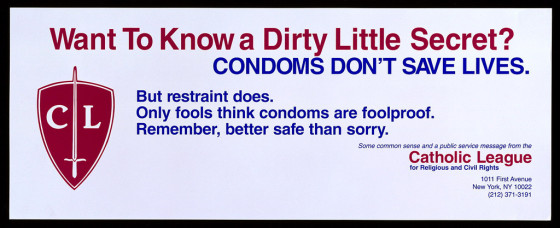The CDC acknowledged the first cases of what is now accepted to be HIV on June 5, 1981 in a “Morbidity and Mortality Weekly Report” (MMWR), which documented instances of a rare lung infection known as Pneumocystis carinii pneumonia (PCP) in five young, previously healthy gay men. The virus swiftly spread, and by 1989 the number of reported AIDS cases grew to 100,000.
The ever climbing death toll prompted gay and queer activists and artists to ban together in sadness and anger over what was viewed by many as the federal government’s complete failure to properly protect and care for at risk communities and people living with HIV/AIDS. Donald Moffett, one of the founding members of Gran Fury, which began as the artistic branch of the AIDS Coalition to Unleash Power (most often referred to as ACT UP), designed the iconic lithographic poster of Ronald Reagan’s face that declares in orange san serif type “HE KILLS ME.”, a critique of President Reagan’s unwillingness to publicly mention AIDS by name for over five years.[1] Echoing ACT UP’s cry that “SILENCE=DEATH”, AIDS activists were outspoken in condemning the shortcomings of politicians, pharmaceutical companies, and religious figures to show adequate support and compassion for people with AIDS; as the disease was closely associated with gay and bisexual men, intravenous drug users, and prostitutes–all groups deemed unsavory when measured against more conservative values–the virus was deeply politicized.
Along with these activist groups seeking to highlight the various social and political inequalities faced by those affected by HIV and AIDS, there emerged numerous health-focused organizations specifically designed to treat and prevent the further spread of the disease. Education was viewed as imperative to spreading scientifically sound information regarding the virus, as well as creating environments of acceptance and support for people living with AIDS. While most political and medical figures were wary of outwardly showing support for any behaviors that may be viewed as immoral (at least in relation to Christian morality), health professionals (including the Surgeon General, C. Everett Koop[2]) emphasized the importance of condom usage during all risky sexual activities and sterile syringe usage with intravenous drugs.
Debates about sex education and condom usage only fanned the already deeply political flames of this discussion, widening the divide between those with secular and Christian values. In response to a number of pro-condom campaigns published by AIDS organizations, in 1994 the Catholic League for Religious and Civil Rights printed a blunt poster that claimed, “Want to know a dirty little secret? CONDOMS DON’T SAVE LIVES.” The message concluded with the “common sense” suggestion: “But restraint does. Only fools think condoms are foolproof. Remember, better safe than sorry.”

Catholic League for Religious and Civil Rights, “Want to Know a Dirty Little Secret?”, 1994. Screenprint on paper.
This Catholic League abstinence-focused tactic stands in stark contrast to a poster produced by the San Francisco AIDS Foundation, a triptych showing a group of smiling men, one wearing a shirt expressing support for safe sex, two men embracing, one donning a tattoo that says “No fear. Safe sex,” and a condom, along with the captions “The moral majority,” “Family values,” and “Right to life.” The San Francisco AIDS Foundation appropriates phrases frequently used by conservative value parties, such as the Catholic League, and applies them in this pro-gay, pro-protection campaign. These two posters seem to communicate with one another, a call and response mirroring the morality debates centered around AIDS throughout the 80s and 90s.
Carlin Soos is a rising second year Master’s student at the Bard Graduate Center and a graduate intern in the Department of Drawings, Prints, and Graphic Design.
[1] This Moffett poster can be seen as a tiled wallpaper at the Whitney Museum of American Art, acting as a backdrop to a Barbara Kruger piece.
[2] Surgeon General Koop published the controversial “Surgeon General’s Report on AIDS” in October 22, 1986. The report emphasized sexual education for children, condom usage for those engaging in casual sex, and clean syringes for drug users. http://profiles.nlm.nih.gov/ps/access/NNBBVN.pdf
